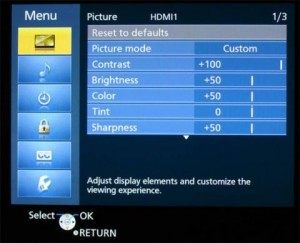Over half of consumers use the TV as out of the box. Do not bother to change the configuration of the various pictures and sound parameters of the device. And that is the factory settings are not intended to provide the best results in every home. On the contrary, are optimized for shops, with the aim that look attractive to potential buyers. TV makers claim that their displays images prove very bright and colorful, to quickly capture the attention of the human eye.
Viewing conditions are different in each house. Neither the size of the room or the location of the device, or the lighting, or the materials and colors of the decoration are equal. So it should take a few minutes to set up the TV correctly. It is an operation that takes little time, but in the long run compensates for much. Refine the various parameters, improves the quality of image and sound, which is adapted to each room. Another added benefit is to reduce eye strain, so that the eyes of the viewers get tired but be in front of the small screen. It is not the only advantages. Changing the factory settings saves energy and increases the life of the appliance.
Calibrate the TV is very easy; simply use the remote control. The first is to reduce the brightness of the TV. An excessive brightness, not only increases the cost of electricity, but is harmful to the eyes viewers, especially in environments that are often in shadow. It is customary for a appliance leaves the factory with the brightness to stop. This implies that the image is constantly changing from very light to very dark, and that represents a on-effort of the pupils, which should be closed and opened continuously. Often, simply put it below the seventy-five percent, and even nearly half, depending on the conditions of the living room.
Second, another important issue in current models is to choose a proper aspect ratio so that the forms do not come out distorted or lost part of the image. When available, the machine can produce good results, sometimes often hidden under names such as “native” or “complete”. In other cases, you need to tinker a bit to find the optimal, especially for TV shows. On the other hand, there are a number of functions that you might want to disable, especially in many advanced televisions, such as brightness or contrast dynamic, which can also appear as dynamic backlight or breeder of black. The same applies to functions related to sharpness, noise reduction (digital) and the enhancer edges, also called super-resolution or resolution plus.
Modern TVs offer picture modes to make life easier for users. Depending on the content you want to show on screen (games, for example), there is a way that includes specific settings for various parameters such as brightness, contrast, color and sharpness. Not all are equal, or apply for the same. Thus, modes of film or film use less energy than other as dynamic or vivid.
Finally, the majority of TVs on the market have their own systems of calibration automatic, or at least, support for configuration. Simply look in the device menu, and go following the instructions step by step. These systems are useful mainly for making fine adjustments related to color temperature, color gamut or gamma correction.
